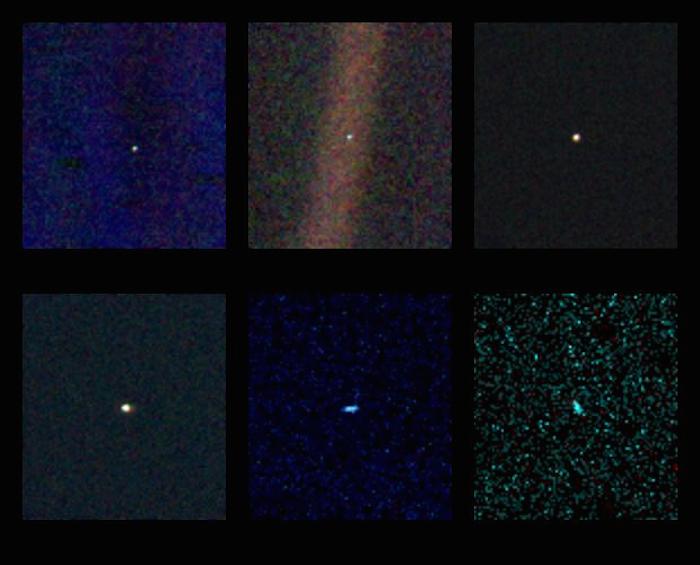.

.
'Pale Blue Dot' Images Turn 25

Valentine's Day is special for NASA's Voyager mission. It was on Feb. 14, 1990, that the Voyager 1 spacecraft looked back at our solar system and snapped the first-ever pictures of the planets from its perch at that time beyond Neptune.
This "family portrait" captures Neptune, Uranus, Saturn, Jupiter, Earth and Venus from Voyager 1's unique vantage point. A few key members did not make it in: Mars had little sunlight, Mercury was too close to the sun, and dwarf planet Pluto turned out too dim.
Taking these images was not part of the original plan, but the late Carl Sagan, a member of the Voyager imaging team at the time, had the idea of pointing the spacecraft back toward its home for a last look. The title of his 1994 book, "Pale Blue Dot," refers to the image of Earth in this series.
"Twenty-five years ago, Voyager 1 looked back toward Earth and saw a 'pale blue dot,' " an image that continues to inspire wonderment about the spot we call home," said Ed Stone, project scientist for the Voyager mission, based at the California Institute of Technology, Pasadena.
The image of Earth contains scattered light that resembles a beam of sunlight, which is an artifact of the camera itself that makes the tiny Earth appear even more dramatic. Voyager 1 was 40 astronomical units from the sun at this moment. One astronomical unit is 93 million miles, or 150 million kilometers.
These family portrait images are the last that Voyager 1, which launched in 1977, returned to Earth. Mission specialists subsequently turned the camera off so that the computer controlling it could be repurposed. The spacecraft is still operating, but no longer has the capability to take images.
"After taking these images in 1990, we began our interstellar mission. We had no idea how long the spacecraft would last," Stone said.
Today, Voyager 1, at a distance of 130 astronomical units, is the farthest human-made object from Earth, and it still regularly communicates with our planet. In August 2012, the spacecraft entered interstellar space – the space between the stars -- and has been delivering data about this uncharted territory ever since. Its twin, Voyager 2, also launched in 1977, is also journeying toward interstellar space.
Voyager 1 is more than three times farther from Earth than it was on Valentine's Day 25 years ago. Today, Earth would appear about 10 times dimmer from Voyager's vantage point.
Sagan wrote in his "Pale Blue Dot" book: "That's here. That's home. That's us. On it everyone you love, everyone you know, everyone you ever heard of, every human being who ever was, lived out their lives. … There is perhaps no better demonstration of the folly of human conceits than this distant image of our tiny world."
-
11.09.2015:
I am currently 15 hrs 03 mins 17 secs of light-travel time from Earth (2015:255:000000:2L)
Ich bin derzeit 15 Std. und 03 min. 17 sek Licht-Reisezeit von der Erde (2015:255: o: 2 L)
-
Quelle: NASA
4060 Views
